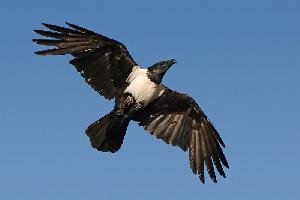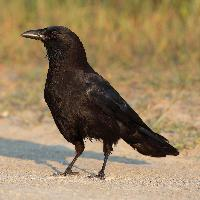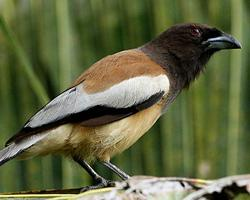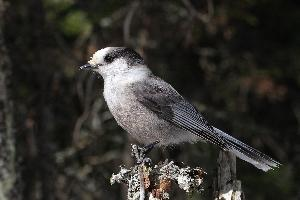
Váhy a míry
| Délka | 29 cm |
|---|
Popis zvířete
The Canada jay, scientifically known as Perisoreus canadensis, is a captivating bird species belonging to the corvid family, which also includes crows, ravens, and magpies. This medium-sized bird is often recognized by its soft, fluffy plumage, predominantly grayish-white with shades of darker gray or black. The bird's appearance is marked by a rounded, stout body, a short bill, and a long tail, which contribute to its distinctive silhouette.One of the most remarkable features of the Canada jay is its adaptability to cold environments. Found primarily in the boreal forests of North America, including parts of Canada, Alaska, and the northern United States, this bird is well-adapted to survive in harsh winter conditions. Its dense plumage not only provides excellent insulation but also makes the bird appear larger than it actually is. This adaptation is crucial for conserving heat during the frigid winter months.
The Canada jay is known for its inquisitive and bold nature. It is not uncommon for these birds to approach humans, displaying a curious and sometimes fearless demeanor. This behavior has earned them various nicknames, such as "whiskey jack," derived from the indigenous Cree name Wisakedjak, which refers to a mischievous spirit known to play tricks on people.
Diet-wise, the Canada jay is omnivorous, feeding on a wide variety of foods ranging from berries, seeds, and nuts to small rodents, carrion, and even the eggs and nestlings of other birds. This opportunistic feeding behavior allows the Canada jay to thrive in its environment, taking advantage of the resources available throughout the seasons.
One of the most fascinating aspects of the Canada jay's behavior is its food storage technique. Known for their remarkable memory, these birds cache food items in various locations for later consumption. They use their saliva to mold food into sticky clumps, which they then adhere to trees or other substrates. This behavior is particularly important during the winter months when food is scarce, and the ability to retrieve cached food ensures their survival.
Breeding typically begins in late winter, with the Canada jay being one of the few bird species to start nesting during this cold season. This early breeding strategy is likely linked to the advantage of having access to abundant food resources for their chicks in the spring. Nests are usually constructed in coniferous trees and are made from twigs, moss, and feathers, providing a warm and protected environment for the eggs and chicks.
In terms of conservation status, the Canada jay is currently not considered endangered or threatened. However, like many wildlife species, it faces challenges due to habitat loss, climate change, and other environmental pressures. Its reliance on cold environments makes it particularly vulnerable to global warming, which could impact its habitat and food storage behavior.
In summary, the Canada jay is a remarkable bird with a unique set of adaptations that allow it to thrive in cold environments. Its curious nature, omnivorous diet, and ingenious food caching behavior make it a fascinating subject of study and an iconic species of the North American boreal forests.
Mapa výskytu
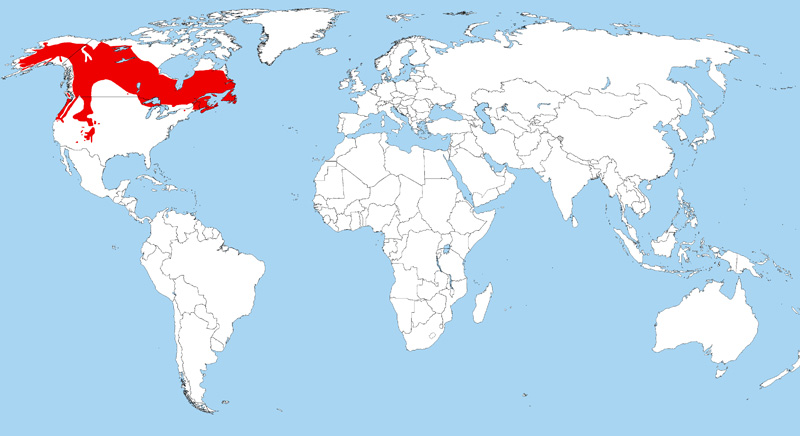
Podobná zvířata
Nové fotografie zvířat
Top 10 zvířat
- Chinese water dragon (Physignathus cocincinus)
- Galápagos tortoise (Geochelone nigra complex)
- Dolphin gull (Leucophaeus scoresbii)
- Japanese macaque (Macaca fuscata)
- Colombian red howler (Alouatta seniculus)
- Sea urchins (Echinoidea)
- Diana monkey (Cercopithecus diana)
- Moustached guenon (Cercopithecus cephus)
- Common house mosquito (Culex pipiens)
- Colossal squid (Mesonychoteuthis hamiltoni)
